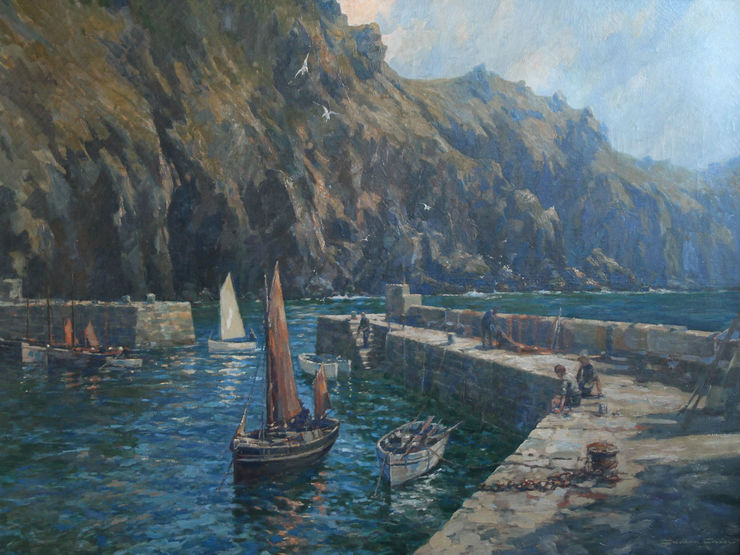Gordon Crosby (1885-1943)
| Artist Name | Gordon Crosby (1885-1943) |
|---|---|
| Title | Mullion Cove Cornwall |
| Description | This beautiful and impressive Royal Academy exhibited British Impressionist landscape oil painting is by noted artist Frederick Gordon Crosby. It was painted and exhibited in 1921 and depicts Mullion Cove and its harbour in Cornwall. Mullion Cove is situated on the west coast of the Lizard Peninsula and is a small sandy beach, mostly covered at high tide, beside the historic lifeboat station and picturesque Mullion harbour. The cove is now looked after by the National Trust and the photograph of the harbour on their website is from a very similar angle to our painting and largely unchanged. Although Crosby is best known for his automobile illustrations he was also a very talented landscape painter, painting in the Scottish highlands and in Cornwall. Two of his three Royal Academy exhibits were of coastal landscapes, of Lelant, exhibited in 1917 and Mullion Cove in 1921, both in Cornwall. Spending time in the West Country, Crosby may well have had connections to the Newlyn School artists in Cornwall, several of whom came from the West Midlands. The painting is a superb marine oil painting of Mullion harbour and vessels in the foreground with figures on the harbour wall. Beyond is the vast range of cliffs, the sea breaking against the rocks and seagulls wheeling over head. The rich palette of blues and greens has the wonderful Cornish School hues and the brushwork is superb. This is a fantastic example of Crosby's work, painted for the sheer enjoyment of painting and was no doubt well received at the Royal Academy in 1921. Signed lower right. |
| Provenance | The Royal Academy 1921 Number 516 entitled Mullion Cove. |
| Medium | Oil on Canvas |
| Size | 47 x 35 inches |
| Frame | Housed in its original gallery exhibition frame. 57 inches by 45 inches. Gallery condition. |
| Condition | Excellent condition. |
| Biography | Frederick Gordon Crosby (1885 – August 1943) was an English automotive illustrator and landscape painter of the Scottish highlands and Cornwall. He worked for the magazine Autocar for most of his life. Crosby attended Christ’s Hospital (Bluecoat) school, just outside London. He married Marjory Dickenson, youngest of seven, in 1913. His first son Peter was born in 1914 and his second son Michael in 1920. Crosby had no formal training as an artist, although he did attend life classes at art school some time after the start of his professional career. In 1908 he started his career as a draughtsman in The Daimler Motor Company’s drawing office. At this time he moved into Arthur Ludlow Clayton’s home in Coventry. This was an environment full of young men, all wildly enthusiastic about the cars of the day. In 1908, Crosby at the age of 23, moved from Daimler to Autocar. It was at Autocar, and at Clayton’s house, that Crosby met and maintained a lifelong friendship with Sammy Davis and Monty Tombs. Crosby, as illustrator, and Tombs and sometimes Davis, as writer, were responsible for producing one of Autocar’s humorous stalwarts: "Keeping up appearances". After some 30 years of travelling and working to press deadlines, the work began to take its toll on Crosby. However, during the war, his spirits seemed to rally and he produced some of his best works of battles both in the air and at sea. Crosby painted some very fine Landscapes, for example the oil paintings he did in 1918-1919 of the Scottish Highlands. At least two works are known to exist. One is in a private collection. The others whereabouts are currently unknown. Crosby exhibited three times at the Royal Academy, the first in 1916 with his painting of Flt. Lt. Reggie Warneford shooting down an L37 over Ghent. This was both the first German zeppelin to be shot down by British aircraft, and the first aeronautical picture ever hung in the Royal Academy. His second RA exhibit was in 1917 and was the Sand Dunes of Lelant, Cornwall. His third RA exhibit in 1921 was our painting, Mullion Cove. His later works were perhaps more for his own pleasure and his last two RA exhibits were both coastal scenes from Cornwall, suggesting Crosby was spending time in the west country and may have had some connection with the Newlyn Art School there. |
| Price | £45000 |

